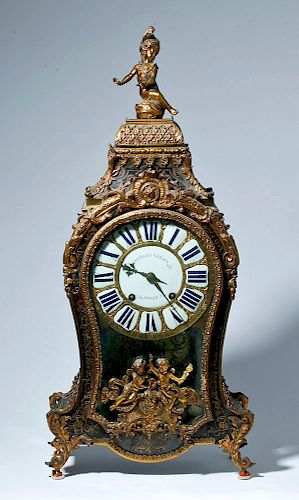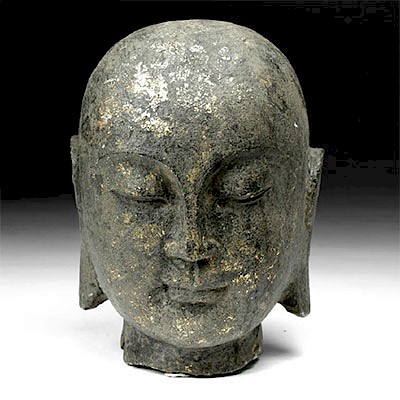Important 18th C. French Rococo Clock - Charles Voisin
Lot 228
About Seller
Artemis Fine Arts
686 S Taylor Ave, Ste 106
Louisville, CO 80027
United States
Selling antiquities, ancient and ethnographic art online since 1993, Artemis Gallery specializes in Classical Antiquities (Egyptian, Greek, Roman, Near Eastern), Asian, Pre-Columbian, African / Tribal / Oceanographic art. Our extensive inventory includes pottery, stone, metal, wood, glass and textil...Read more
Estimate:
$10,000 - $12,000
Absentee vs Live bid
Two ways to bid:
- Leave a max absentee bid and the platform will bid on your behalf up to your maximum bid during the live auction.
- Bid live during the auction and your bids will be submitted real-time to the auctioneer.
Bid Increments
| Price | Bid Increment |
|---|---|
| $0 | $25 |
| $300 | $50 |
| $1,000 | $100 |
| $2,000 | $250 |
| $5,000 | $500 |
| $10,000 | $1,000 |
| $20,000 | $2,500 |
| $50,000 | $5,000 |
| $100,000 | $10,000 |
| $200,000 | $20,000 |
About Auction
By Artemis Fine Arts
Nov 29, 2018
Set Reminder
2018-11-29 10:00:00
2018-11-29 10:00:00
America/New_York
Bidsquare
Bidsquare : Holiday Glitz - Ancient / Ethnographic Art
https://www.bidsquare.com/auctions/artemis-gallery/holiday-glitz---ancient-ethnographic-art-3672
What to give this holiday season? Think silver, gold, bronze, shiny, glittery, wearable, festive. We ship worldwide and handle all shipping in-house for your convenience. This is one sale you don't want to miss! Artemis Fine Arts info@artemisfinearts.com
What to give this holiday season? Think silver, gold, bronze, shiny, glittery, wearable, festive. We ship worldwide and handle all shipping in-house for your convenience. This is one sale you don't want to miss! Artemis Fine Arts info@artemisfinearts.com
- Lot Description
Europe, France, Paris, Rococo (Roccoco, Late Baroque), case by André-Charles Boulle (1642-1732), movement by Charles Voisin (1685-1761), ca. 1725 CE. An exceptional clock of cast bronze foliate and rocaille over wood case surmounted by a exotic female personification of Asia dressed in rich fabrics seated upon an orb representing that continent. Below the clockface are two cherubs, one holding a torch to light the incense burner that the other is preparing (incense being an attribute often associated with personifications of Asia), and a crowing rooster, the universal bird solar symbol throughout Eurasia as it’s crow heralded the dawn and was believed to dispel evil spirits at dawn and the light of day eclipsed the darkness of night. In addition, faces of brass marquetry on wood grace the case. Size: 15" L x 7" W x 36" H (38.1 cm x 17.8 cm x 91.4 cm)
Please Note: special shipping is required for this clock, please inquire prior to purchase
The case of this clock is attributed to André-Charles Boulle (French, 1642-1732, master before 1666) dubbed "the most skillful artisan in Paris" by his contemporaries. According to the curatorial staff of the J. Paul Getty Museum, "André-Charles Boulle's name is synonymous with the practice of veneering furniture with marquetry of tortoiseshell, pewter, and brass. Although he did not invent the technique, Boulle was its greatest practitioner and lent his name to its common name: boulle work. Boulle also specialized in floral marquetry in both stained and naturally colored wood. Many of his designs are illustrated in a book of engravings published around 1720. Before 1666 Boulle was awarded the title of master cabinetmaker; in 1672 the king granted him the royal privilege of lodging in the Palais du Louvre. In the same year, he achieved the title of cabinetmaker and sculptor to Louis XIV, king of France. This new title allowed him to produce furniture as well as works in gilt bronze such as chandeliers, wall lights, and mounts. Although strict guild rules usually prevented craftsmen from practicing two professions simultaneously, Boulle's favored position allowed him protected status and exempted him from these statutes." (http://www.getty.edu/art/collection/artists/947/andr-charles-boulle-french-1642-1732-master-before-1666/
The movement of this clock is inscribed "Charles Voisin" (French, 1685-1761, master 1710) who was a master clockmaker in 18th century Paris. Voisin was sought after by elite clientele including members of the royal family and French aristocracy. In the early 18th century, grandiose palace-rooted culture of Baroque France (think Louis XIV Palace of Versailles) was replaced by a more intimate private townhouse based Rococo culture. Intellectuals and aristocrats gathered in elaborately decorated salons painted in delicate pastel colors with elaborately ornamented curving walls covered with gilded mirrors and sculptural ornament depicting sprays of flowers, rocaille shells, floating cherubs, and birds. French Rococo interiors were total works of art bedecked with fancifully wrought furniture, small sculptures, ceramics, decorative tapestries and mural paintings as well as small wonders like this clock.
Clock movements by Voison and cased created by Boulle have been collected by some of the most prestigious institutions including the J. Paul Getty Museum and the Metropolitan Museum of Art.
Provenance: Ex- Private Washington State Collection
All items legal to buy/sell under U.S. Statute covering cultural patrimony Code 2600, CHAPTER 14, and are guaranteed to be as described or your money back.
A Certificate of Authenticity will accompany all winning bids.
We ship worldwide and handle all shipping in-house for your convenience.
#113600Missing one side panel of glass, minor areas of expected wear. In the process of being mechanically restored to perfect working condition. Guaranteed.Condition
- Shipping Info
-
All shipping is handled in-house for your convenience. Your invoice from Artemis Gallery will include shipping calculation instructions. If in doubt, please inquire BEFORE bidding for estimated shipping costs for individual items.
-
- Buyer's Premium



 EUR
EUR CAD
CAD AUD
AUD GBP
GBP MXN
MXN HKD
HKD CNY
CNY MYR
MYR SEK
SEK SGD
SGD CHF
CHF THB
THB




















